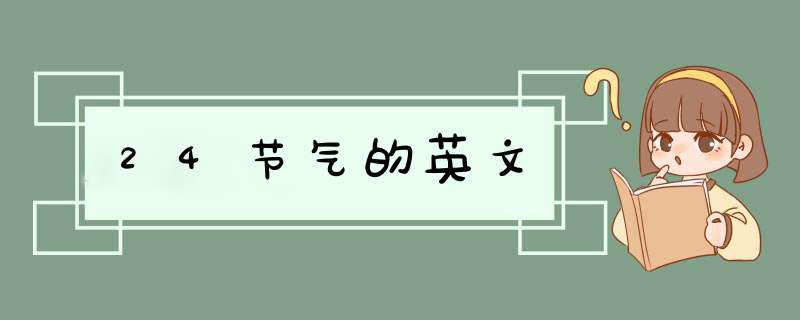
二十四节气英文如下:
1、立春、立夏、立秋、立冬
立春、立夏、立秋和立冬放在一起记忆,“立”是开始的意思,英语都是beginning of
立春Beginning of Spring;立夏Beginning of Summer;立秋Beginning of Autumn;立冬Beginning of Winter。
2、春分、秋分、夏至、冬至
春分/秋分放在一起记忆,“分”是昼夜平分的意思,英语中对应的单词是equinox。
春分Spring Equinox;秋分Autumn Equinox。
同样地,夏至/冬至放在一起记忆,“至”即至日、至点的意思,英语为solstice。
夏至Summer Solstice;冬至Winter Solstice。
3、小暑、大暑、小雪、大雪、小寒、大寒
小暑/大暑、小雪/大雪、小寒/大寒可放在一起记忆,英语中“大”用major,“小”用minor。
小暑Minor Heat;大暑Major Heat;小雪Minor Snow;大雪Major Snow;小寒Minor Cold;大寒Major Cold。
4、白、寒露
白/寒露也可以放在一起记忆,英语都是Dew(露水)。
白露White Dew;寒露Cold Dew。
2016年,我国申报的“二十四节气—中国人通过观察太阳周年运动而形成的时间知识体系及其实践”(The Twenty-Four Solar Terms: Chinese knowledge of time and practices developed through observation of the sun's annual motion)就已经入选联合国教科文组织《人类非物质文化遗产代表名录》。
立春 Beginning of Spring:"立"是开始的意思,立春就是春季的开始。
雨水 Rain Water:降雨开始,雨量渐增。
惊蛰 Insects Awakening:蛰是藏的意思。惊蛰指春雷乍动,惊醒了蛰伏在土中冬眠的动物。
春分 Spring Equinox:"分"是平分的意思。春分表示昼夜平分。Equinox是天文学上的昼夜平分点
的意思。(equi-就是表示“相等”的前缀)
清明 Fresh Green:天气晴朗,草木繁茂。
谷雨 Grain Rain:雨生百谷。雨量充足而及时,谷类作物能茁壮成长。
立夏 Beginning of Summer:夏季的开始。
芒种 Grain in Ear:麦类成熟。ear在这里是“穗”的意思
夏至 Summer Solstice:炎热的夏天来临。solstice是天文学上的至日、至点的意思。“夏至”也是
一年中白昼最长的一天。
小暑 Lesser Heat:“暑”是炎热的意思。小暑就是气候开始炎热。
大暑 Greater Heat:一年中最热的时候。
立秋 Beginning of Autumn:秋季的开始。
处暑 End of Heat:"处"是终止、躲藏的意思。处暑是表示炎热的暑天结束。
白露 White Dew:天气转凉,露凝而白
秋分 Autumnal Equinox:昼夜平分。
寒露 Cold Dew:露水以寒,将要结冰。
霜降 First Frost:天气渐冷,开始有霜。
立冬 Beginning of Winter:冬季的开始。
小雪 Light Snow:开始下雪。
大雪 Heavy Snow:降雪量增多,地面可能积雪。
冬至 Winter Solstice:寒冷的冬天来临。“冬至”也是天文学上一年中白昼最短的一天
冬至 Winter Solstice:寒冷的冬天来临。“冬至”也是天文学上一年中白昼最短的一天
大寒 Greater Cold:一年中最冷的时候。
联合国教科文组织保护非物质文化遗产政府间委员会第十一届常会于2016年11月28日至12月2日在
埃塞俄比亚首都亚的斯亚贝巴联合国非洲经济委员会会议中心召开。11月30日下午委员会经过评
审,正式通过决议,将中国申报的“二十四节气——中国人通过观察太阳周年运动而形成的时间知
识体系及其实践”列入联合国教科文组织人类非物质文化遗产代表作名录。既然我们的二十四节气
的文化地位已经变得越来越重要了,那么要记住这些节气的英文表达就很有必要了!
每年的公历四月五日前后为清明节,是二十四节气之一。今年的清明节是4月4日。在二十四个节气中,既是节气又是节日的只有清明。清明节是我国传统节日,也是最重要的祭祀节日。按照旧的习俗,祭祀(扫墓)时,人们要携带酒食果品、纸钱等物品到墓地,将食物供祭在亲人墓前,再将纸钱焚化,为坟墓培上新土,折几枝嫩绿的新枝插在坟上,然后叩头行礼祭拜,最后吃掉酒食回家。
清明节,又叫踏青节,正是春光明媚草木吐绿的时节,也正是人们春游的好时候,所以古人有清明踏青,并开展一系列体育活动的的习俗。直到今天,清明节祭拜祖先,悼念已逝的亲人的习俗仍很盛行。
问题补充:每年的公历四月五日前后为清明节,是二十四节气之一。今年的清明节是4月4日。在二十四个节气中,既是节气又是节日的只有清明。清明节是我国传统节日,也是最重要的祭祀节日。按照旧的习俗,祭祀(扫墓)时,人们要携带酒食果品、纸钱等物品到墓地,将食物供祭在亲人墓前,再将纸钱焚化,为坟墓培上新土,折几枝嫩绿的新枝插在坟上,然后叩头行礼祭拜,最后吃掉酒食回家。
清明节,又叫踏青节,正是春光明媚草木吐绿的时节,也正是人们春游, 强身健体的好时候,所以古人有清明踏青,并开展一系列体育活动的的习俗。直到今天,清明节祭拜祖先,悼念已逝的亲人的习俗仍很盛行。
The Gregorian calendar year before April 5 for tomb-sweeping day, 24 solar is one This is the tomb-sweeping day on April 4 In the twenty four seasons, is also the only qingming festival nights Chinese traditional festival, is also the most important holiday of sacrifice According to the old tradition, the grave), sacrifice (people to carry fruits, especially to the graveyard, pack items will be food for the offerings in the family grave, again will pack incineration, grave in new soil, fold a few branches in the new green grave, then KouTou salute, especially home last eat worship
Tomb-sweeping day, also called TaQingJie TuLu vegetation, spring season, also is the good people, so a spring outing, and the ancients had clear outing launched a series of sports activities Until today, the tomb-sweeping day, our ancestors have relatives customs still prevail
Thenbsp;24nbsp;solarnbsp;termsnbsp;isnbsp;anbsp;grossnbsp;namenbsp;ofnbsp;thenbsp;systemnbsp;thatnbsp;comprisesnbsp;ofnbsp;12nbsp;majornbsp;solarnbsp;termsnbsp;andnbsp;12nbsp;minornbsp;solarnbsp;termsnbsp;interlacednbsp;withnbsp;eachnbsp;othernbsp;nbsp;Startingnbsp;fromnbsp;“vernalnbsp;equinox“,nbsp;thenbsp;12nbsp;majornbsp;solarnbsp;termsnbsp;arenbsp;“vernalnbsp;equinox“,nbsp;“cornnbsp;rain“,nbsp;“cornnbsp;forms“,nbsp;“summernbsp;solstice“,nbsp;“greatnbsp;heat“,nbsp;“endnbsp;ofnbsp;heat“,nbsp;“autumnalnbsp;equinox“,nbsp;“frost“,nbsp;“lightnbsp;snow“,nbsp;“winternbsp;solstice“,nbsp;“severenbsp;cold“nbsp;andnbsp;“springnbsp;showers“nbsp;nbsp;Eachnbsp;majornbsp;solarnbsp;termnbsp;fallsnbsp;onnbsp;onenbsp;ofnbsp;thenbsp;12nbsp;lunarnbsp;monthsnbsp;designatednbsp;bynbsp;thenbsp;12nbsp;earthlynbsp;branchesnbsp;(Figurenbsp;1)nbsp;nbsp;Thenbsp;minornbsp;solarnbsp;termnbsp;afternbsp;“vernalnbsp;equinox“nbsp;isnbsp;“brightnbsp;andnbsp;clear“,nbsp;andnbsp;thennbsp;innbsp;turnnbsp;“summernbsp;commences“,nbsp;“cornnbsp;onnbsp;ear“,nbsp;“moderatenbsp;heat“,nbsp;“autumnnbsp;commences“,nbsp;“whitenbsp;dew“,nbsp;“coldnbsp;dew“,nbsp;“winternbsp;commences“,nbsp;“heavynbsp;snow“,nbsp;“moderatenbsp;cold“,nbsp;“springnbsp;commences“nbsp;andnbsp;“insectsnbsp;waken“Fromnbsp;thenbsp;Earth‘snbsp;perspective,nbsp;thenbsp;Sunnbsp;movesnbsp;throughnbsp;anbsp;yearnbsp;acrossnbsp;thenbsp;starsnbsp;ornbsp;celestialnbsp;spherenbsp;alongnbsp;anbsp;pathnbsp;knownnbsp;asnbsp;thenbsp;ecliptic,nbsp;whichnbsp;isnbsp;measurednbsp;innbsp;360nbsp;degreesnbsp;longitudenbsp;nbsp;Thenbsp;24nbsp;solarnbsp;termsnbsp;dividenbsp;thenbsp;eclipticnbsp;intonbsp;24nbsp;equalnbsp;segments,nbsp;withnbsp;15nbsp;degreesnbsp;ofnbsp;thenbsp;Sun‘snbsp;longitudenbsp;betweennbsp;thenbsp;termsnbsp;nbsp;Atnbsp;“vernalnbsp;equinox“,nbsp;thenbsp;Sun‘snbsp;longitudenbsp;isnbsp;nbsp;0nbsp;degree;nbsp;atnbsp;“brightnbsp;andnbsp;clear“,nbsp;thenbsp;Sun‘snbsp;longitudenbsp;isnbsp;15nbsp;degrees;nbsp;andnbsp;sonbsp;forthnbsp;(Tablenbsp;1)Atnbsp;“vernalnbsp;equinox“nbsp;andnbsp;“autumnalnbsp;equinox“,nbsp;thenbsp;periodsnbsp;ofnbsp;daylightnbsp;andnbsp;thenbsp;nightnbsp;arenbsp;equalnbsp;innbsp;lengthnbsp;nbsp;Thenbsp;periodnbsp;ofnbsp;daylightnbsp;isnbsp;thenbsp;longestnbsp;atnbsp;“summernbsp;solstice“nbsp;andnbsp;thenbsp;shortestnbsp;atnbsp;“winternbsp;solstice“nbsp;(northernnbsp;hemisphere)nbsp;nbsp;Thesenbsp;werenbsp;thenbsp;earliestnbsp;solarnbsp;termsnbsp;determinednbsp;innbsp;ancientnbsp;timenbsp;nbsp;Thennbsp;itnbsp;camenbsp;thenbsp;fournbsp;solarnbsp;termsnbsp;“springnbsp;commences“,nbsp;“summernbsp;commences“,nbsp;“autumnnbsp;commences“nbsp;andnbsp;“winternbsp;commences“nbsp;nbsp;Othernbsp;solarnbsp;termsnbsp;werenbsp;namednbsp;laternbsp;accordingnbsp;tonbsp;thenbsp;weathernbsp;andnbsp;agriculturalnbsp;activitiesnbsp;prevalentnbsp;atnbsp;thenbsp;respectivenbsp;timesnbsp;ofnbsp;thenbsp;seasonsnbsp;nbsp;Thenbsp;“24nbsp;solarnbsp;terms“nbsp;reflectsnbsp;tonbsp;somenbsp;e
二十四节气英语表达如下:
1、Spring begins 立春。
2、The rains 雨水。
3、Insects awaken 惊蛰。
4、Vernal Equinox 春分。
5、Clear and bright 清明。
6、Grain rain 谷雨。
7、Summer begins 立夏。
8、Grain buds 小满。
9、Grain in ear 芒种。
10、Summer solstice 夏至。
11、Slight heat 小暑。
12、Great heat 大暑。
13、Autumn begins 立秋。
14、Stopping the heat 处暑。
15、White dews 白露。
16、Autumn Equinox 秋分。
17、Cold dews 寒露。
18、Hoar-frost falls 霜降。
19、Winter begins 立冬。
20、Light snow 小雪。
21、Heavy snow 大雪。
22、Winter Solstice 冬至。
23、Slight cold 小寒。
24、Great cold 大寒。
关于二十四节气的英文例句:
1、The 24 solar terms reflect the changes of nature and have been used for agricultural purposes for over 2000 years in China
24节气反映了自然的变化,被中国人用于农业目的已经有超过2000年的历史。
2、The 24 solar terms are not only an important part of traditional Chinese culture but also an invaluable source of knowledge about climate and ecology
24节气不仅是中国传统文化的重要组成部分,而且是关于气候和生态知识的宝贵来源。
3、The celebration of each solar term is a time when people can observe the changes of nature and appreciate the beauty of the world around them
每个节气的庆祝是人们观察自然变化、欣赏周围世界美丽的时刻。
用英语来介绍24节气如下:
1、start of spring:立春。
2、rain water:雨水。
3、awakening of insects:惊蛰。
4、vernal equinox:春分。
5、clear and bright:清明。
6、grain rain:谷雨。
7、start of summer:立夏。
8、grain full:小满。
9、grain in ear:芒种。
10、summer solstice:夏至。
11、minor heat:小暑。
12、major heat:大暑。
13、start of autumn:立秋。
14、limit of heat:处暑。
15、white dew:白露。
16、autumnal equinox:秋分。
17、cold dew:寒露。
18、frost descent:霜降。
19、start of winter:立冬。
20、minor snow:小雪。
21、major snow:大雪。
22、winter solstice:冬至。
23、minor cold:小寒。
24、major cold:大寒。
二十四节气(The24SolarTerms)是指中国农历中表示季节变迁的24个特定节令,是根据地球在黄道(即地球绕太阳公转的轨道)上的位置变化而制定的,每一个分别相应于地球在黄道上每运动15°所到达的一定位置。
二十四节气是中国先秦时期开始订立、汉代完全确立的用来指导农事的补充历法,是通过观察太阳周年运动,认知一年中时令、气候、物候等方面变化规律所形成的知识体系。
它把太阳周年运动轨迹划分为24等份,每一等份为一个节气,始于立春,终于大寒,周而复始,既是历代官府颁布的时间准绳,也是指导农业生产的指南针,日常生活中人们预知冷暖雪雨的指南针,是汉族劳动人民长期经验的积累成果和智慧的结晶。
二十四节气对应的英文名和日期分别是:
立春:theBeginningofSpring(1stsolarterm)Feb3,4, or 5;
雨水:RainWater(2ndsolarterm)Feb18,19 or 20;
惊蜇:theWakingofInsects(3rdsolarterm)Mar5,6 or 7;
春分:theSpringEquinox(4thsolarterm)Mar20,21 or 22;
清明:PureBrightness(5thsolarterm)Apr4,5 or 6;
谷雨:GrainRain(6thsolarteram)Apr19,20 or 21;
立夏:theBeginningofSummer(7thsolarterm)May5,6 or 7;
小满:LesserFullnessofGrain(8thsolarterm)May20,21 or 22;
芒种:GraininBeard(9thsolarterm)Jun5,6 or 7;
夏至:theSummerSolstice(10thsolarterm)Jun21 or 22;
小暑:LesserHeat(11thsolarterm)Jul6,7 or 8;
大暑:GreaterHeat(12thsolarterm)Jul22,23 or 24;
立秋:theBeginningofAutumn(13thsolarterm)Aug7,8 or 9;
处暑:theEndofHeat(14thsolarterm)Aug22,23 or 24;
白露:WhiteDew(15thsolarterm)Sep7,8 or 9;
秋分:theAutumnEquinox(16thsolarterm)Sep22,23 or 24;
寒露:ColdDew(17thsolarterm)Oct8 or 9;
霜降:Frost'sDescent(18thsolarterm)Oct23 or 24;
立冬:theBeginningofWinter(19thsolarterm)Nov7 or 8;
小雪:LesserSnow(20thsolarterm)Nov22 or 23;
大雪:GreaterSnow(21thsolarterm)Dec6,7 or 8;
冬至:theWinterSolstice(22thsolarterm)Dec21,22 or 23;
小寒:LesserCold(23thsolarterm)Jan5,6 or 7;
大寒:GreaterCold(24thsolarterm)Jan20 or 21。
“二十四节气”介绍:
二十四节气,是历法中表示自然节律变化以及确立“十二月建”的特定节令。一岁四时,春夏秋冬各三个月,每月两个节气,每个节气均有其独特的含义。
廿四节气准确的反映了自然节律变化,在人们日常生活中发挥了极为重要的作用。它不仅是指导农耕生产的时节体系,更是包含有丰富民俗事象的民俗系统。廿四节气蕴含着悠久的文化内涵和历史积淀,是中华民族悠久历史文化的重要组成部分。
-二十四节气
欢迎分享,转载请注明来源:表白网

 微信扫一扫
微信扫一扫
 支付宝扫一扫
支付宝扫一扫
评论列表(0条)